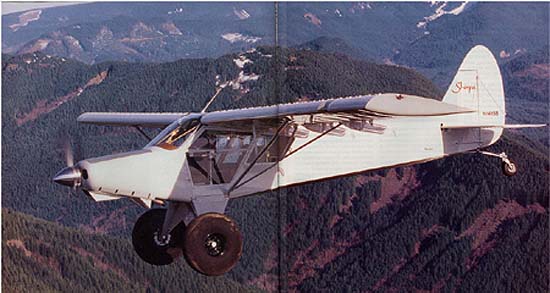
Sherpa

Once in a while you have an experience that so opens your eyes you suddenly realize how little you know about certain segments of aviation. And its exciting! It's damned exciting to suddenly be soaking up raw knowledge in the form of equally raw experiences which add so much to your understanding that the effect is immeasurable. I just had one of those experiences and it kept me awake for days designing airplanes in my dreams. What has me so fired up? I just flew the Sherpa! You know...that humungous bush bird which showed up at Oshkosh last year and looks like a Super Cub on steroids. It's the one with a severe foot condition. More than just flying it, I was forcefully inserted into the world of hard core bush flying for which the Sherpa was designed. When I returned home I babbled on like an idiot about the experience for hours but found my tales were split and focused on two different subjects: The first was the Sherpa itself, but I found it did no good to speak of the airplane without putting it in context. It does no good to talk about a bush or utility airplane without truly understanding the world in which it lives because very few of us really know what that world consists of. We may think we know about bush flying but believe me, we don't.
I learned how little I knew about bush flying and what it demanded as soon as I walked up to the Sherpa's birthplace and company headquarters; Byron Root's hangar complex, which was located mid-field on his private strip in the suburbs of Portland, Oregon. There was maybe 350 feet of runway extending past the hangars in both directions with tall trees at one end while the last 100 feet at the other end dropped off at a steep angle before disappearing entirely at a small cliff. The surface snaked through the trees, bucking, twisting and turning as it went, and had water standing in the low spots. And this was their main airport! In all his years bouncing in and out of river beds and canyons, Byron learned from experience what it takes in terms of the hardware to both get in and not break. More than once he's had to walk many, many miles for help after landing somewhere and having the airplane break. In conversations with him certain subjects continually resurface and those are what formed the seeds for the Sherpa development.
He arrived at these through continually flying airplanes deemed to be bush planes and finding what doesn't work and what breaks. For instance, he doesn't like spring gear and aluminum airplanes because the gear throws up rocks which tear up the tail and the gear is too easily eaten by hidden rocks and holes. He prefers rag and tube because it is less likely to suffer unflyable damage (duct tape is great stuff!) and is easier to repair and beef up. In his continual upgrading of his own Super Cub, he kept breaking parts and beefing them up, changing and evolving the airplane until today it boasts a six cylinder, 0-540 Lycoming and what is essentially a redesigned, beefed up fuselage. He and his friends take their flying so seriously they've enlisted the aid of a radar gun to evaluate aircraft slow speed performance. Using the radar gun they determined that many of the much vaunted short field airplanes, like the Helio Courier, may be able to fly really slowly across the airport, but when it comes time to land on an extremely short strip, they have to come in 5-7 knots faster because they have to put the nose down to see the end of the runway. As I was to find out myself, the ability to see the exact spot you want to hit is paramount to short, rough field work. And you have to use both words together, "short" and "rough" because that's what defines most bush strips for the airplanes that utilize them on a regular basis. |